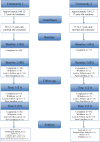Multi-Level Cultural Intervention for the Prevention of Suicide and Alcohol Use Risk with Alaska Native Youth: a Nonrandomized Comparison of Treatment Intensity
- PMID: 28786044
- PMCID: PMC5803385
- DOI: 10.1007/s11121-017-0798-9
Multi-Level Cultural Intervention for the Prevention of Suicide and Alcohol Use Risk with Alaska Native Youth: a Nonrandomized Comparison of Treatment Intensity
Abstract
Suicide and alcohol use disorders are primary determinants of health disparity among Alaska Native people in contrast to the US general population. Qungasvik, a Yup'ik word for toolbox, is a strengths-based, multi-level, community/cultural intervention for rural Yup'ik youth ages 12-18. The intervention uses "culture as intervention" to promote reasons for life and sobriety in young people using local expertise, high levels of community direction, and community based staff. The intervention is grounded in local practices and adaptive to local cultural differences distinctive to rural Yup'ik communities. The current study compares the effectiveness of high-intensity intervention in one community (treatment), operationalized as a high number of intervention activities, or modules, implemented and attended by youth, contrasted to a lower intensity intervention in a second community (comparison) that implemented fewer modules. A Yup'ik Indigenous theory of change developed through previous qualitative and quantitative work guides intervention. In the model, direct intervention effects on proximal or intermediate variables constituting protective factors at the individual, family, community, and peer influences levels lead to later change on the ultimate prevention outcome variables of Reasons for Life protective from suicide risk and Reflective Processes about alcohol use consequences protective from alcohol risk. Mixed effects regression models contrasted treatment and comparison arms, and identified significant intervention effects on Reasons for Life (d = 0.27, p < .05) but not Reflective Processes.
Keywords: Alcohol; American Indian/Alaska Native; Community intervention; Community-based participatory research; Suicide.
Conflict of interest statement
Conflict of Interest: The authors, including the Qungasvik Team, our community research partners, and the estate of David Henry declares they have no conflicts of interest.
Figures


References
-
- Allen J, Fok CCT, Henry D, Skewes M. People Awakening Team. Umyuangcaryaraq “reflecting”: Multidimensional assessment of reflective processes about the consequences of alcohol use among Yup’ik Alaska Native youth. American Journal of Drug and Alcohol Abuse. 2012;38(5):468–475. doi: 10.3109/00952990.2012.702169. - DOI - PMC - PubMed
Publication types
MeSH terms
Grants and funding
LinkOut - more resources
Full Text Sources
Other Literature Sources

